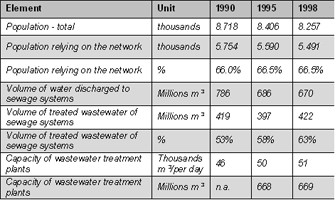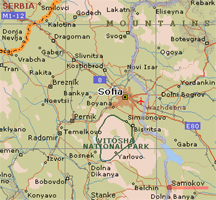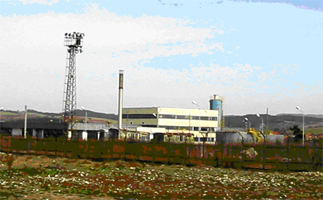 |
 |
 |
 |
 |
 |
 |
 |
 |
 |
 |
 |
Project description
Name of the case study
Construction of Municipal Waste Water Collector No 5, Samokov Municipality
Description of context
National Strategy for the Environment and Action Plan 2000-2006
The Strategy comprises an environment and SWOT analysis, strategic objectives, action plan and its financial support.
The specific objectives in the water sector are to guarantee sufficient quality and quantity of water supply to both the population and the industrial enterprises by:
• Overcoming the insufficiency in water provision;
• Water provision for irrigation;
• Creating awareness and commitment in efficient use of water resources;
• Preserving and improving the quality of underground and surface waters.
One of the conclusions made in the scan analysis outlined that “while the water supply infrastructure is relatively well developed and covers almost all of the population, the level of development of sewage system and urban waste water treatment plants is much lower and might be assessed as unsatisfactory.”
Adopted in 1999 National Program on Priority Construction of Urban Waste Water Treatment Plants (National Program) set 19 priority actions according to the analysis results and the specific objectives. Among them 5 concern the reduction of the water pollution and the construction of the urban waste water treatment plant within the.
Description of project - background
National level
The National Program concerns settlements with equivalent population [population equivalent (p.e.) – the amount of oxygen-demanding substances whose oxygen consumption during biodegradation equals the average oxygen demand of the waste water produced by one person. For practical calculations, it is assumed that one unit equals 54 grams of BOD per 24 hours. (United Nation Statistic Division – Environment Glossary);] over 10 000. It is currently implemented in 36 Bulgarian municipalities in order to meet a number of assessed shortcomings:
• Unsatisfactory development of the sewerage system and the urban waste water treatment plants (UWWTP);
• Scarce water resources in Bulgaria compared to other countries in Europe;
• Pollution in water bodies resulting in risks for the social, ecological and economic development of the country;
• Poor technical status and unaccomplished construction works of sewage systems;
• Lack of compatibility between existing sewage systems and waste water treatment plants;
• Considerable part of operating UWWTPs overloaded or not working with full capacity

Selected data on sewage and wastewater treatment in Bulgaria (source: National Statistical Institute)
Municipal level
By the time the National Program started in 1999, the Urban Waste Water Plant of Samokov had been abandoned unfinished because of insufficient financial resources. The reasons for resuming the construction process were: (1) the number of the equivalent population (46 000 was above the minimum of 10 000 required by the National Program); (2) the Iskar river, where the waste water is discharged, is among the ones with highest ranking (with the strictest ecological requirements) in the country as it later provides drinking water for Sofia and flows into the Danube (see map below); (3) the current high percentage of urban sewage coverage (70% of the town) and (4) the availability of an already finalised executive projects for the plant and the adjacent technical infrastructure.

Locality of Samokov and Iskar river
A Technical and Economic Report (TER) had been developed in late 1980s reviewing the whole sewage system of the town and the part of the collectors discharging the waste water to the planned UWWTP. It included: (i) analysis of the existing situation; (ii) argumentation for the support of future needs concerning the main and secondary sewage system collectors; (iii) design projects. TER had justified the need for six main collectors in the town.
The UWWTP was put into operation in 2001. A next step was the required urgent accomplishment of the adjacent urban water and the sewage network of six town collectors. The main collector (No.1) was already constructed but the rest collectors (from No.2 to No.6) discharging waste water into it were unfinished yet.
In 2004 collectors No.1 and No.4 are already functioning; collector No.6 is only partially built. Collector No.3 has no direct connection with the functioning of the UWWTP and will be constructed later on. According to the design project (included in TER), collector No.2 had to serve the historical town centre whereas collector No.5 a newly built residential quarter. Both had to discharge the waste water into the collector No.1. Because of the restricted local financial resources the Municipality had to apply for financial support within the running National Program. Only one of the two collectors (No 5 or No 2) could be included in the application and the construction of the other one had to be postponed.
Actors involved in the project:
Ministry of Environment and Waters, Municipality of Samokov, a municipal construction company (Samokovconsult Ltd).
Description of project - objectives/aims
National level
The aims of the National Program are: (1) defining the priorities for construction of UWWTPs downstream the rivers; (2) upgrading, reconstruction and modernisation of existing UWWTPs; (3) planning and construction of new UWWTPs. 12 criteria (including equivalent population number, rank of the river, place of wastewater discharge etc.) were weighted according to an expert rating methodology called Criteria Relative Weight Evaluation (CRWE).
Municipal level
The aims of the projects were:
• discharge of the waste waters into collector No.1 and afterwards to the UWWTP;
• reduce pollution levels of Iskar river.
Description of project - time interval and stages
National level
Two stages for realisation were outlined in the National Program based on the financial resources available and expected:
• 1999 to 2002 – available resources from the national budget and national financial institutions;
• 2002 to 2005 – national budget sources supplemented by expected grants from EU programs.
According to the National Program until the end of 2005 all the UWWTPs regarded should be accomplished and functioning.
Municipal level
The UWWTP project developed in three stages:
• Stage I - UWWTP accomplishment;
• Stage II - construction of the sedimentation tanks for biological rectification;
• Stage III - reconstruction and accomplishment of the adjacent urban network (pipelines, collectors, etc).
In 2001, Stage I was over (see photo below)) and Stages II and III started together.

The Urban Waste Water Treatment Plant in Samokov
Description of project - financing
National level
The projects for UWWTP building and reconstruction are jointly supported under a co-financial scheme by:
• National Budget;
• National Fund for Environmental Protection (NFEP);
• Municipal Fund for Environmental Protection – 10% of the financial support granted by NFEP.
The Municipality of Samokov is one of the municipalities included in the National Program. Its local UWWTP was chosen among 32 possible plants ranked by CRWE.
Municipal level
The financing of collector No. 5 construction has realised according to the active co-financial scheme proposed within the National Program (see above) in three stages:
• 1st stage (2002) - 1000000 BGN (~ 500 000 EUR);
• 2nd stage (2003) – 400 000 BGN (~200 000 EUR);
• 3rd stage (2004) – 634 000 BGN (~317 000 EUR).
The actual municipal financial contribution for the 3rd stage exceeded the initial anticipation in the project budget (10% of the financial support granted by NFEP) as additional works concerning the replacement of telephone cables and street pavement after the construction of the waste water system were not initially envisaged in the calculations. The collector construction is managed by Samokovconsult Ltd municipal company.
Description of project - other sectors involved
National level
At national level a direct link with the waste sector is reported. The sediments from UWWTP should be stored in specialised waste depots which are not sufficient yet. A construction program for waste depots is going on in parallel.
What tools were used to assess sustainability?
Procedure for Criteria Relative Weight Evaluation (Tool used at National Level)
Technical and Economic Report (TER) + Local Priority Criteria (LPC) (Municipal Level)
More information